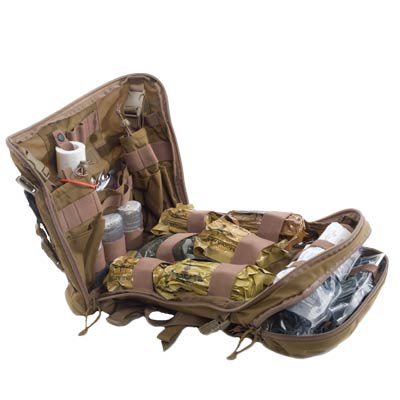How many times have you been at the range and thought “What do we do if someone gets shot or injured during training?” You’d be surprised to learn that there are a lot of range facilities that do not have a posted Emergency Medical Action Plan (EMAP) in place to deal with serious on-site injuries! Sure, they may have a policy protocol established in their range operations manual, but who is responsible for executing it? Have they been trained appropriately on how to respond to medical emergencies and what resources are available on site to actually deal with serious injuries?
If you do ask that question at the range, most of the time the response will be to use the first-aid kit that is available on site and to call 911 for serious injuries. It’s obvious that there needs to be a much more detailed plan other than just slapping a band-aid on a wound and waiting for EMS to arrive.
It has been my experience when inquiring about EMAPs at range facilities that they are not all prepared to deal with serious medical emergencies and lack proper equipment and training to deal with trauma injuries.
So let’s explore some steps on how to establish a reliable EMAP and how it can be implemented so students, instructors and range staff alike will know these procedures and what actions to take at the onset of each training evolution.
Start out by acquiring medical supplies and build medical kits that can be easily identified and accessible on the range. I recommend building a First-Aid Kit, a Trauma Injury Kit and AED Kit.
The First-Aid Kit is typically built using a heavy duty plastic tool box or tackle box that is orange or yellow in color. Use an indelible black marker to write FIRST AID KIT on the front, back and sides of the box in large letters so it can be easily identified.
The First-Aid Kit will include all of the essential medical supplies that will be used for non-serious injuries and will be accessed regularly to treat small scrapes, cuts and other minor injuries. This kit should be monitored on a regular basis to ensure that used items are replenished.
The Trauma Injury Kit is typically built using a heavy duty plastic tool box, tackle box or soft canvas bag that is RED in color. Use an indelible black marker to write TRAUMA KIT on the front, back and sides of the box or bag so it can be easily identified.
While this kit will rarely, if ever, be accessed (hopefully you won’t need to use this kit!) it should also be monitored regularly so items with expiration dates can be rotated out and replaced with fresh supplies.The Trauma Injury Kit will include all of the essential medical supplies that are needed to treat serious trauma injuries such as; hemorrhage control, deep lacerations, penetrating puncture wounds, gunshot wounds, sucking chest wounds and tension pneumothorax.
The Trauma Injury Kit should ONLY be accessed for serious injuries and by personnel that have been properly trained in TCCC (Tactical Combat Casualty Care) or training of equivalent level.
The AED Kit (Automated External Defibrillator) is something that every range facility needs to acquire and have available at all times. While AED units can be purchased new, with a little work searching on the Internet, you should be able to find a source that will donate a decommissioned unit for your facility.
The First-Aid Kit, Trauma Injury Kit and AED Kit should be kept on-site where the training is actually taking place and immediately accessible. These kits will be useless if they are kept in a range building down the road or in a vehicle parked 100 yards away!
The next step is to establish a communication protocol to contact 911 for EMS response. While hard line phones may be on-site, they might not be immediately accessible on the range. I recommend assigning at least (2) range staff members or students with reliable cell phone service to keep their phones with them on the range in the event a 911 call needs to be made. Another option is to have a police radio on the range for direct contact with dispatch. Assign (2) people to emergency call duties in case one of them is the person that is injured.
Create a laminated handout, outlining the EMAP, that can be kept on the range and accessible with the medical kits. The handout should contain the physical address of the range facility, GPS coordinates (for Life Flight dispatch) and the direct phone number to EMS dispatch. The direct number is important, as a 911 call on most cell phones may not always reach the dispatch center for the area you are training at. Having the direct number to dispatch available, the people assigned to emergency call duty can preprogram that number into their cell phones.
Include the name, address and phone number to ER of the closest Level 1 Trauma Center in the laminated handout in the event the decision is made to use one of the vehicles on site to grab and go vs. waiting for an ambulance. Sometimes it may be quicker to drive someone to the local hospital vs. waiting for EMS to respond. If you do decide to grab and go, make sure a phone call is made to the hospitals ER in transition from the range to the hospital to notify them of what you have and ETA to ER.
In summary, review the EMAP with everyone at the beginning of each training evolution during the range safety briefing. Show everyone in the class where the medical kits will be located on the range. Identify range staff that are TCCC qualified. Identify any students in the class that might have a medical skills background and recruit them to assist the range staff, should a medical emergency occur.
Assign at least (2) reliable people on the range to emergency phone call duties and verify the direct dispatch number, GPS coordinates and range address with them. Make sure they know where the laminated EMAP handout is located with this information.
Lastly, if a serious injury incident does occur, whether you decide to wait for EMS or grab and go to the hospital, be sure to secure the area where the incident occurred as responding LEO’s will be required to process that area as part of their investigation. It is also recommended that anyone that witnessed the incident remain on scene for LEO debrief.
If you follow these procedures and develop a sound EMAP, you’ll be ready to handle any emergency medical situation that occurs on your range.
As always, stay safe, remain vigilant and Fight to Win!
John Krupa III – Bio
John is a police officer with the Orland Hills Police Dept. (IL.) and has over 24 years of experience in law enforcement. He has previously served as a patrol officer, FTO and firearms instructor with the Chicago Police Dept. He is a recipient of the Award of Valor, Silver Star for Bravery and Distinguished Service Award for his actions in the line of duty. He is a certified Master Firearms Instructor from PTI and graduate firearms instructor from the Secret Service Academy, FBI, DEA and FLETC. He holds the rating of Distinguished Weapons Expert with the Department of Homeland Security and has presented numerous courses at training conferences across the country including ASLET, IALEFI and ILEETA. John can be reached at – jkrupa@teamspartan.com







![LETC [2014] 114](https://www.actiontarget.com/wp-content/uploads/2015/02/LETC-2014-114.jpg)

![LETC [2014] 282](https://www.actiontarget.com/wp-content/uploads/2015/02/LETC-2014-282.jpg)
